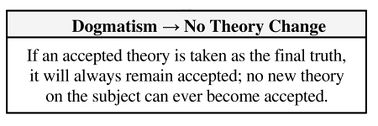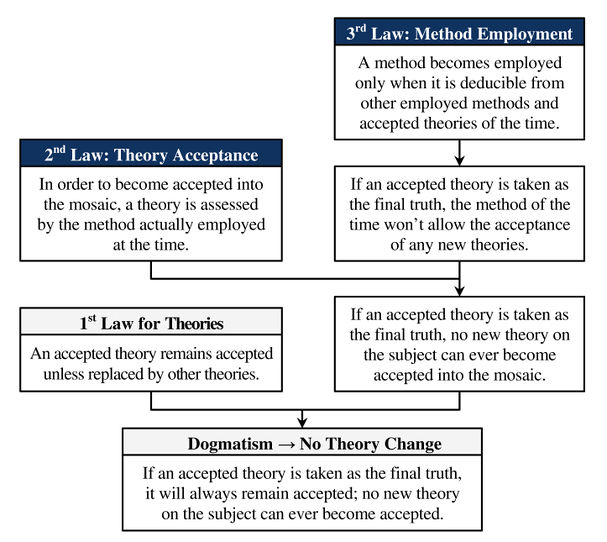Dogmatism No Theory Change theorem (Barseghyan-2015)
This is an answer to the question Changeability of the Scientific Mosaic that states "If an accepted theory is taken as the final truth, it will always remain accepted; no new theory on the subject can ever be accepted."
Dogmatism No Theory Change theorem was formulated by Hakob Barseghyan in 2015.1 It is currently accepted by Scientonomy community as the best available answer to the question.
Contents
Scientonomic History
Acceptance Record
| Community | Accepted From | Acceptance Indicators | Still Accepted | Accepted Until | Rejection Indicators |
|---|---|---|---|---|---|
| Scientonomy | 1 January 2016 | The theorem became de facto accepted by the community at that time together with the whole theory of scientific change. | Yes |
Question Answered
Dogmatism No Theory Change theorem (Barseghyan-2015) is an attempt to answer the following question: Under what circumstances does scientific change become impossible?
See Changeability of the Scientific Mosaic for more details.
Description
No theory acceptance may take place in a genuinely dogmatic community. "Namely," as is noted in Barseghyan (2015), Barseghyan notes, when introducing the theory rejection theorem in Barseghyan (2015), "theory change is impossible in cases where a currently accepted theory is considered as revealing the final and absolute truth".1p. 165
The gist of this theory can be illustrated by the following examples.
How to tell if a community is genuinely dogmatic?
Barseghyan emphasizes that with the Dogmatism No Theory Change theorem, "we can easily distinguish between genuinely dogmatic communities and communities which only appear dogmatic".1p. 166. He presents the following example:
It was once believed that the medieval scientific community with its Aristotelian mosaic was a dogmatic community, for it (allegedly) held on to its theories at all costs and disregarded all new theories. Yet, upon closer scrutiny it becomes obvious that the Aristotelian-medieval community was anything but dogmatic. Had the medieval community indeed taken a genuinely dogmatic stance, no scientific change would have been possible in their mosaic. But it is a historical fact that the Aristotelian-medieval mosaic was gradually changing especially in the 16th and 17th centuries; towards the end of the 17th century many of its key elements were replaced by new elements. Finally, by circa 1700 the Aristotelian-medieval system of theories was replaced with those Descartes and Newton. This would have been impossible had the theories of the mosaic been actually taken as revealing the final truth. Thus, the Aristotelian-medieval community was not dogmatic. For some real examples of dogmatic communities think of those communities which, having started with some dogmas, fanatically held on to those dogmas and never considered their modification possible.1p. 166-7
Reasons
Reason: Deduction of the Dogmatism No Theory Change theorem
Suppose a community has an accepted theory that asserts that it is the final and absolute truth. By the Third Law we deduce the method: accept no new theories ever. By the Second Law we deduce that no new theory can ever be accepted by the employed method of the time. By the First Law, we deduce that the accepted theory will remain the accepted theory forever.1p. 165-167
This reason for Dogmatism No Theory Change theorem (Barseghyan-2015) was formulated by Hakob Barseghyan in 2015.1
If a reason supporting this theory is missing, please add it here.
Questions About This Theory
There are no higher-order questions concerning this theory.
If a question about this theory is missing, please add it here.

